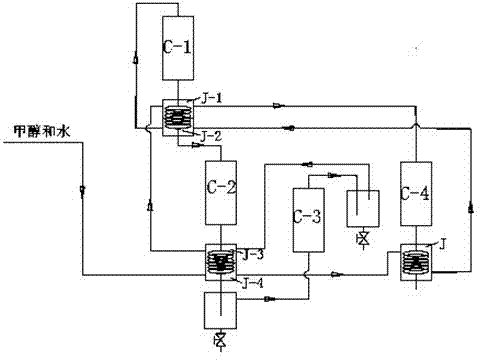Process for preparing high-octane high-cleanness gasoline with methanol by using multi-element catalysis method
A technology of high octane number and methanol, which is applied in the petroleum industry, preparation of ether by addition of unsaturated compounds, preparation of ether, etc., can solve problems such as unreported processes, and achieve the effect of saving energy
- Summary
- Abstract
- Description
- Claims
- Application Information
AI Technical Summary
Problems solved by technology
Method used
Image
Examples
example 1
[0067] The first reactor C-1 is equipped with 20 grams of No. 1 catalyst, and the reaction temperature is: the preheater B-1 controls 200°C, the first reactor C-1 controls 460°C (D-1 shows the temperature); the second reactor C-2 is equipped with 20 grams of No. 2 catalyst, and the third reactor C-3 is equipped with 20 grams of No. 3 catalyst. Feed pump A-1 feeds 134.5 grams in four hours, including 55.5 grams of water, 79 grams of methanol, and 34.562 grams of hydrocarbons. 12.5 grams of base gasoline was produced in four hours (weighed, released from storage tank F-2), and the chromatographic data was sampled from sampling port H-2:
[0068] Methane 1.1070% accounts for 0.7060% of the carbon and hydrogen numbers of methanol.
[0069] 15.2518% of isobutene accounts for 9.7361% of the hydrocarbon number of methanol.
[0070] Isoamylene 1 accounted for 5.3493% and Isoamylene 2 accounted for 9.5388%.
[0071] The measured gas flow rate from the sampling port H-2 is 22.98 gram...
example 2
[0073] The temperature of the third reactor C-3 is raised to 75°C (D-3 shows the temperature), the gas of Example 1 enters the third reactor C-3, the feed pump A-2 feeds methanol 6ml / h, and the gas from the sampling port H- Gas samples were taken from port 3 for analysis. The isobutene content was 7.2586%, and the measured gas was 15.843 grams. 3.365 grams of isobutene enters the C-3 reactor, 1.150 grams remain after the reaction, and the conversion rate is 65.8%. The etherified gas contained 3.807 grams of oil, 9.288 grams of olefins after etherification, and 2.748 grams of alkanes, accounting for 7.95% of the hydrocarbon number of methanol.
example 3
[0075] C-1-C-4 reactors are filled with the following catalyst quantities: No. 1 catalyst 20g, No. 2 catalyst 20g, No. 3 catalyst 20g, and No. 4 catalyst 30g.
[0076] Feeding: A-No. pump 20g methanol and 15g water mixed feed per hour, A-2 pump enters methanol 6ml / h.
[0077] Reaction conditions: normal pressure reaction, temperature is 460°C for D-1, 300°C for D-2, 80°C for D-3, and 310°C for D-4.
[0078] 12-hour product: 80.1 g of base gasoline, 20.26 g of oxygenated oil, and 50.34 g of methanol remaining.
[0079] The ratio of the output oil material to the alcohol-oil input into methanol reaches 2.46 tons. Methanol produces 1 ton of oil products, of which the octane number of the base oil is 93.8, and the octane number of the oxygenated oil is 100. The oil does not contain sulfur and nitrogen elements. , the tail gas contains 10.1g of hydrocarbons, including 15% oil and 12% dry gas.
PUM
| Property | Measurement | Unit |
|---|---|---|
| specific surface area | aaaaa | aaaaa |
| specific surface area | aaaaa | aaaaa |
| adsorption capacity | aaaaa | aaaaa |
Abstract
Description
Claims
Application Information
 Login to View More
Login to View More - R&D
- Intellectual Property
- Life Sciences
- Materials
- Tech Scout
- Unparalleled Data Quality
- Higher Quality Content
- 60% Fewer Hallucinations
Browse by: Latest US Patents, China's latest patents, Technical Efficacy Thesaurus, Application Domain, Technology Topic, Popular Technical Reports.
© 2025 PatSnap. All rights reserved.Legal|Privacy policy|Modern Slavery Act Transparency Statement|Sitemap|About US| Contact US: help@patsnap.com


